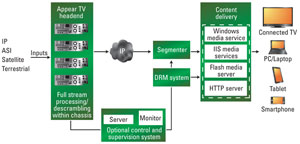Appear TV’s Multiscreen system
In the competitive world of broadcasting, being able to address a multitude of distribution formats has become mandatory for survival. In the beginning, there was terrestrial broadcast for widely distributed programming, although through a maze of different international standards. Next in the technical line was cable, followed in short order by satellite. Although broadcasters had to address two additional formats to distribute content, the end target was still a home television screen.
With digital broadcast standards in place and the emergence of Internet, Wi-Fi and, now, 4G programming pathways, standard computers and smart devices such as the iPhone and iPad are now capable of receiving content from any broadcaster anywhere on the planet. The problem with this avalanche of potential receiver units is the corresponding flood of distribution formats required to make each device happy, combined with the expectation of instantaneous availability of content on these distribution formats from its users. Clearly, solving the multi-screen dilemma is of the utmost importance for the modern broadcaster.

Figure 1. The Appear TV Multiscreen’s open architecture allows it to receive signals through a variety of interfaces — including XML and SOAP — and deliver them to devices ranging from connected TVs to smartphones.
Go to the headend of the class
Although a number of manufacturers have introduced new dense, software-based transcoding and encoding platforms into the OTT/multi-screen marketplace, they are still unable to keep up with the large volume of incoming content to be processed. Furthermore, transcoding in itself doesn’t address the additional functions needed to prep a program to be pushed to a segmenter, such as content acquisition, descrambling and the encoding of baseband signals, leaving a broadcaster to implement additional equipment. This workflow also brings with it the complexities of integrating different manufacturers’ units into a workable and reliable system.
The fully integrated Appear TV Multiscreen system simultaneously prepares multiple signals from multiple sources in multiple formats for distribution to an HD television in the home, for a high-resolution computer screen, and lower-resolution Web- and mobile-based profiles, all at different bit rates optimized for each destination device. This is possible through the new multi-screen encoding and transcoding cards for the Appear TV Unified headend system chassis. The cards, along with the rest of the system, offer a scalable option that can be integrated into an existing system to expand capabilities or implemented from the ground up for a new headend.
The future is in the cards
The Multiscreen encoding and transcoding cards provide a dense transcoding capability, supporting multiple profiles and bit rates simultaneously for multi-screen delivery. From one card, it is able to handle much of the preparation needed before content is sent from the main broadcast hub to local affiliates or online outlets. Its functions include input service replication, resolution change, interlace-to-progressive conversion, graphics rescaling and key-frame alignment. The end results of this setup are key-frame-aligned outputs in transport-stream format that are easily pushed along the broadcast chain.
The professional video industry's #1 source for news, trends and product and tech information. Sign up below.
Many similar solutions in the market offer software-based dense transcoding platforms, but only have IP interfaces with no provision for accepting baseband SDI/HD-SDI inputs or to turn around services from any input source. The Multiscreen system also provides the capability to support baseband inputs for encoding, as well as transcoding while maintaining high density and optimal systems integration.
For those looking for a complete system, the Unified headend chassis can hold a range of purpose-built cards, in addition to the encoding and transcoding cards, to handle switch IP/IO control, descrambling, audio leveling, DVB-S/S2, terrestrial, cable demodulating, multiplexing, modulation and general-purpose IP-IO, among many other capabilities.
Keeping IT simple
In terms of its core operations, all functionality within the headend can be configured and monitored using its integrated web-based user interface. Additionally, the system has a completely agnostic, open architecture with interfaces that include XML, SOAP and other industry-standard protocols. In this way, the Multiscreen system can work in conjunction with a range of installed systems, making it easy to implement enhanced capabilities for little investment.
With segmentation playing a big part in the distribution of these new streaming formats, the transcoding card can be configured to be compliant with a number of third-party segmentation devices. This allows broadcasters to maintain the segmentation devices already in place while still expanding their capabilities.
Multi-function solution
Broadcasters are in need of a single, multi-function platform that is capable of offering significant transcoding density, while providing comprehensive coverage of the other critical pieces required for a multiformat, adaptive-stream headend system. Although current software-based alternatives focus on dense transcoding, they lack flexibility and functionality in other key areas, forcing facilities to combine systems from multiple manufacturers. The new Multiscreen system is designed to resolve all of these problems.
—Carl Walter-Holst is CEO of Appear TV.
